
This is PAGE 2 of the 1970s exhibit. Go here for PAGE 3.

1970-1979: THE LED COMES OF AGE




This messy collage shows something that is probably
quite rare and may be a prototype that was never produced:
A near-1970 ORANGE LED!
This LED appears to have the same GaAs (gallium arsenide) substrate and GaAsP (gallium arsenide phosphide) emitting layer as a circa. 1970 red of the same design, but there's a lot more P (phosphorous) in this LED
than in the red LED of the same design. This was apparently not an easy task.
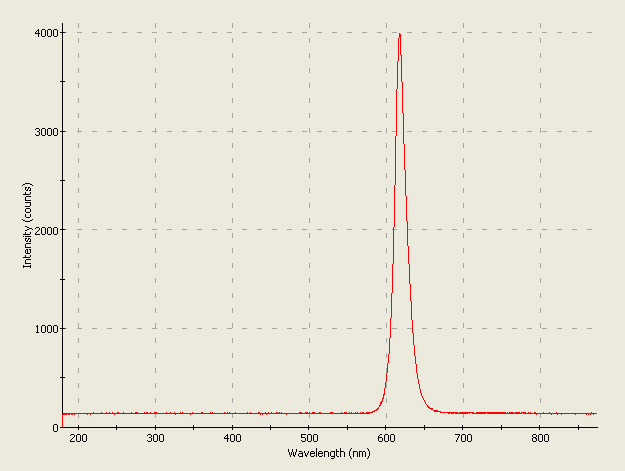
Spectrographic analysis of this LED.
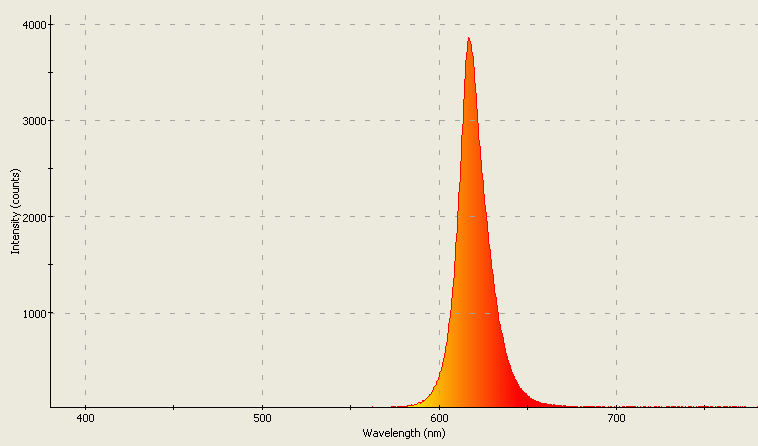
Same as above; newer spectrometer software & settings used.
Here is the info I received from the local LED guru, Don Klipstein:
" Color more constant, no green peak, and efficiency dropping instead of
increasing at low currents means probably the thin active layer is GaAsP
with more P and less As than the 60 percent As 40 percent P used in
original formula red. Could have been tough to make - more P than As is
easier to make if the substrate is GaP (orangish, tan, brown, yellow, or
maybe transparant) rather than GaAs (black). This one may be a prototype
that did not go into production due to difficulty of making a 60 percent P
40 percent As layer on a GaAs substrate.
In the 1970's, GaAsP with mostly 60-40 (red-orange to orange-red) and
90-10 (amber-"yellow") P/As ratio came out on a GaP substrate."


This is one of the more unusual vintage LEDs I've come across.
The person who gave it to me claimed it had two dice (light emitting chips) but that one of them had burnt out.
That's what I thought too, until I tried a little experiment. I connected it to power, and it glowed yellow. Then I hooked it up backwards,
and it still glowed yellow. (!)
Turns out, this LED is a two-chip yellow, specifically made for use in an AC circuit. When one half of the AC cycle is on, one of the yellow
LED chips glows; and when the other half of the AC cycle comes up, the first chip extinguishes and the second chip then lights.
Lather, rinse, repeat.
Both chips appear to be carefully matched, as they glow the exact same color and intensity as one another.



LEFT: A green LED packaged in an orange plastic case. Hmmmm...
RIGHT: Two variations of the TLR-147, an LED with a Fresnel lens top commonly available in Radio Shack stores
(under the Archer label) in the late 1970s. These were meant to be installed where a wide viewing angle indicator was needed.



I came across another one of these metal-based LEDs like the famous "liquid nitrogen" model shown on the next page of this 1970s exibit.
Examining the LED shows the metal base is only a ring that encircles the base; you can see through the LED by looking at it
from the base. It is still not clear what the metal ring was for; as in this configuration, it would make a lousy heatsink.


This early red LED uses a mask contact instead of a ball bond.
As a result, LEDs like this tend to have really strange looking LED chips.
Several types of mask contact LEDs are shown within the Museum's pages.
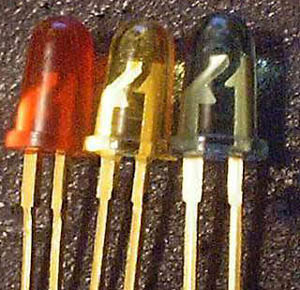
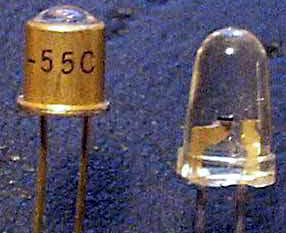
Here are some early contenders in the color LED war. Coming in red, yellow, and green; these LEDs manufactured by Monsanto
found their way into lots of products and into lots of hobbyist's hands. They were not very bright, and could easily be drowned out
in a bright room - but they were mysterious, fascinating devices that every tinkerer had to get their hands on.
For the colored LEDs in the first picture, the part numbers are MV5023, MV5222, and MV5322. If you're from Monsanto and think I have the part numbers assigned to the wrong colors, please feel free to write in
and correct me. My original information was lost in an earthquake along with the computer that hosted it.
The two in the rightmost photograph are NIR (near-infrared) LEDs; the one in the metal can is a GE part, and it is not known who made the clear one, though it may *possibly* be a Fairchild FLV-100.
All five of these LEDs date from 1972 to 1973.
From an email I received on 05-23-08, comes the following
(his name & email address have been omitted to help protect his privacy):
Hi Craig,
I worked for Teltherm here in New Zealand during the early 70s. We
manufactured short and long range infra-red perimeter security beams.
They consisted of a pulse generator and current amplifier to drive an
infra-red LED, depending on the type of diode used, up to one and a bit
amps. The receiver used a quad op-amp and amplified the pulse from a
small silicon solar cell up high enough to saturate a diode pump that
drove a tiny 5 volt relay. When the beam was broken, the relay dropped
out and all hell broke loose. Well the cops were informed that the
building had been entered and they arrived in due course, usually after
the burglars had left. If you pointed a good torch at the receiver, the
relay dropped out and... There weren't many false alarms out in the
field if they were set up correctly. We ran classes in mounting and
wiring them to make certain that they were set up correctly. Some alarm
installers were thick.
The LEDs we used were made by GE and Monsanto. The
http:///ledmonsant2.jpg reminds me of those 2
types that we used. The metal cased ones were the GE variety and the
plastic one was the Monsanto variety. I wish I had kept the data sheets
that I copied out. They were pretty ragged when I tossed them out. Very
early Xerox copies. The short range beam was 30 meters and the long
range beam was 100 meters. They didn't like glass and it reduced the
span to about 15 meters if you shone it through one piece of glass that
was a quarter of an inch thick. They loved perspex. Our cover was
injection molded from what looked like very dark green perspex and when
you held it up to the sun, it was a very dark red. Disolve a bit of the
cover in chloroform (the only solvent for perspex that I know of) and it
turned a deep red. It didn't take much to color 50mls either. Again
Monsanto to the fore. We had lenses molded as well and if they weren't
the correct shape, the distance was severly reduced. The reject rate was
extremely high. Just as well it's recycleable.We did our developement
work with red LEDs that had the same characteristics as the infra-red
LEDs so that we could see what we were doing. Our building was old and
dark and had long passages that were ideal for this type of work. Mad
scientists we were, we'd walk along these dark passages yelling "It's
alive". It didn't half echo. Teltherm has gone now and the building has
gone too, disappeared into history. There's a monstrosity of a tower
block in its place.
By the way, NKT on a device usually signified that it was made by
Newmarket Electronics in England. We had a couple of sample FIREs (Fast
Infra Red Emitters) that looked like golden quarter inch bolts with
glass domes on the heads. We pumped these at something like 5 amps and
got about a mile during the day and 5 miles during the night. They had
to have a large heat sink to get to full power. There were a few decent
hills in Auckland that we could get to the top of in a vehicle and have
access to the top of our building. Boy did we some strange looks from
the on-lookers. We used turned lenses for these experiments. The lathe
operator was a wizard! A six inch lens inside a piece of PVC drain pipe.
It was heavy. I think that they were looking a making an infra-red
barrier for some of our maximum security prison yards.
Keep up the great site,
Cheers for now.

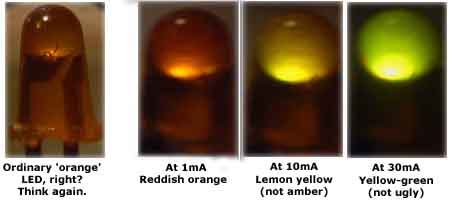
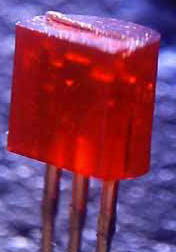
On the left is an orange LED. As you can see, something interesting happens: when you increase the current, the LED visibly and dramatically changes color. At very low currents of a couple of milliamps or so, you get the nice orange you see in the far left. And as you increase the current to close to 30-40mA, you get the lime green on the right.
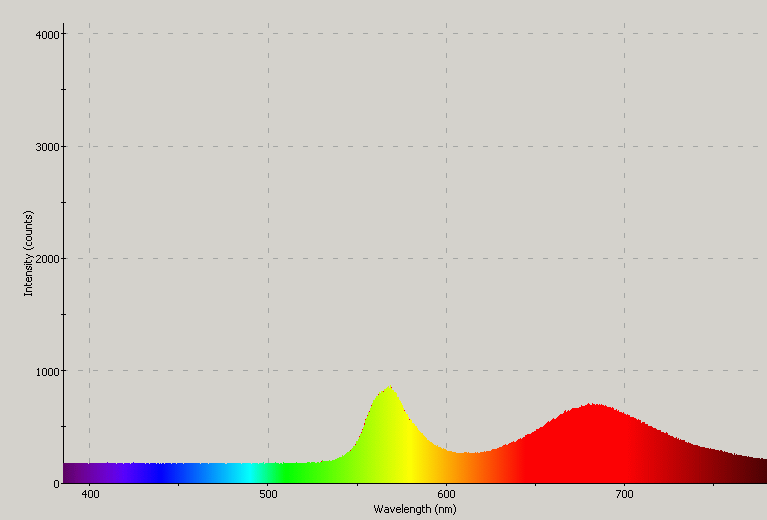
Spectrographic analysis of this LED at an If of ~28mA.
(Update 04-12-08): I've been informed by an LED expert on the east coast who's work I implicitely trust that this LED may in fact be one of those wily & elusive (and fairly rare) two-chip yellow LEDs!!! This LED uses a a GaP red chip and GaP green chip together (connected in parallel) to make yellow.
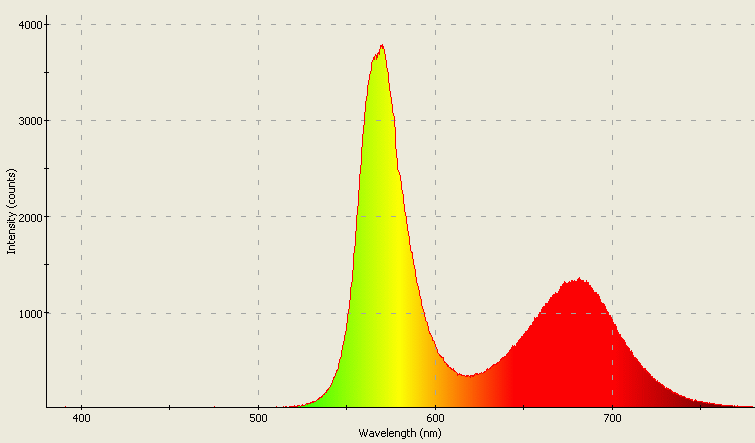
Spectrographic analysis of this LED; If (forward current)= ~50mA.
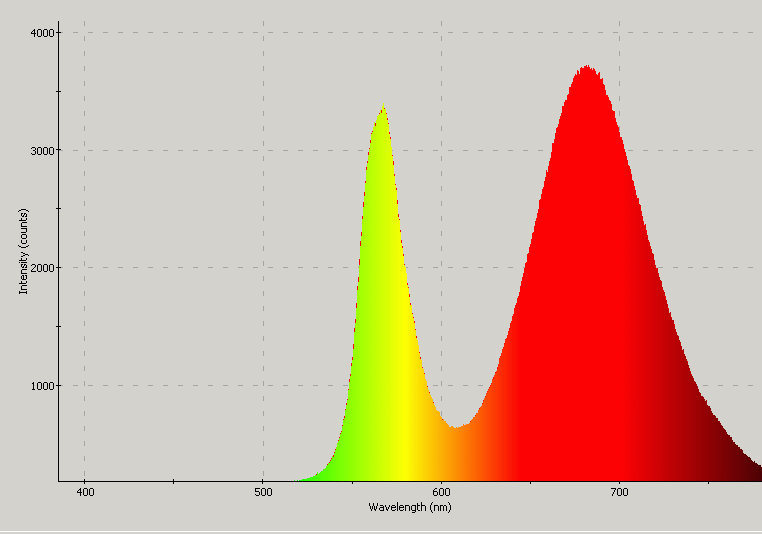
Spectrographic analysis again; If was just under 30mA for this test.
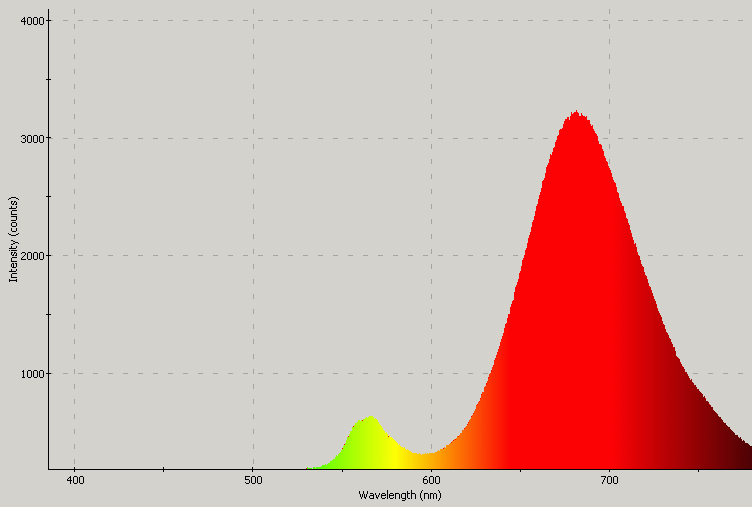
Spectrographic analysis yet again; If (forward current) was just under 2mA for this test.
Note that the red peak is much higher here than it is in the previous spectrum.
The LED has a distinct orange color here; it appears yellow - bordering on greenish-yellow when the If approaches 30mA.
The odd looking LED on the right (in the photograph above the three spectrographic analyses) comes in a standard sized TO92 transistor case, but emits a very usable red light rather than acting like a typical transistor. One e-mailer speculates it may have been a voltage reference, but I'm not sure how to test that theory just yet. Another source (a former Motorola insider) thinks they were made by Motorola for Eastman Kodak to be used inside one type of camera. Cost effectiveness was the issue here; just use the existing machinery they had on hand for making transistors. The center lead is the cathode; and only one of the outer leads (for the anode) was actually used; the other doesn't connect to anything.

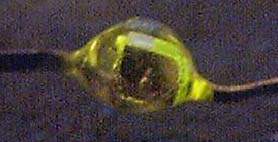


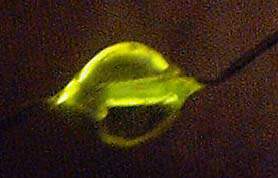
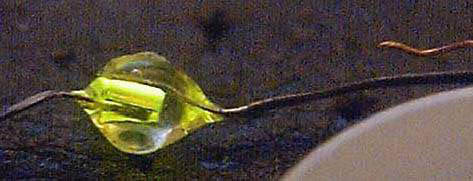 These amazing pictures show a very rare LED from Russia.
Manufactured sometime between 1972 and 1973, this greenish-yellow LED gets its light from a chip of silicon carbide, a material
most of you know as an abrasive substance used for sandpaper! Although fluorescence in SiC was discovered by Henry Joseph Round as early as 1907, this is the first known practical application for that ghostly greenish glow.
These amazing pictures show a very rare LED from Russia.
Manufactured sometime between 1972 and 1973, this greenish-yellow LED gets its light from a chip of silicon carbide, a material
most of you know as an abrasive substance used for sandpaper! Although fluorescence in SiC was discovered by Henry Joseph Round as early as 1907, this is the first known practical application for that ghostly greenish glow.
The LED's light output (from its normal "this side up" orientation) is only 10 Ácd (that's ten microcandelas).
It came in two versions: a tiny pinhead-sized glass encapulated version like this for commercial use, and another in a sturdy metal can for military use.
I have a lot of additional information about this LED hidden away in various e-mails, but since a lot of damage was done in the Ash Wednesday 2001 earthquake, it will be quite a while before I can pry myself away from disaster recovery and fetch that info - actually as of 05-23-08, that information is completely irretrievable. 

This is PAGE 2 of the 1970s exhibit. Go here for PAGE 3.

* 1960 * 1970 * 1980 * 1990 * 2000 *
RETURN TO MUSEUM LOBBY
This page is a frame from a website.
If you arrived on this page through an outside link,you can get the "full meal deal" by clicking here.


































